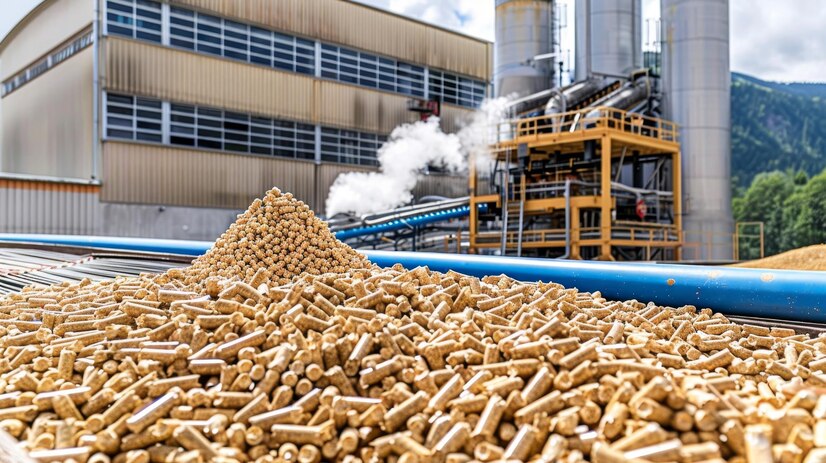Pelletierung is more than just a buzzword in the manufacturing and sustainability sectors. It’s a process that transforms various raw materials into compact, efficient pellets, making them easier to handle and transport. As industries increasingly seek sustainable solutions, pellet production has surged in popularity. But what exactly goes on behind the scenes?
In this blog post, we’ll dive deep into the science of pellet production. From understanding how pellets are made to exploring their wide-ranging applications across different sectors, you will discover why pelletization is becoming an essential component of modern industry practices. Whether you’re a seasoned professional or simply curious about this fascinating process, there’s something here for everyone interested in the world of Pelletierung!
Understanding the Process of Pelletization
Pelletization is a fascinating process that transforms raw materials into small, round pellets. This method enhances the efficiency of handling and transportation.
The journey begins with the preparation of the feedstock. Materials are ground to achieve a uniform particle size. This consistency is crucial for effective compaction.
Next, moisture content plays a vital role. A precise balance ensures that the material binds effectively during compression. Too much or too little moisture can lead to poor-quality pellets.
As pressure builds in the pelletizer, particles fuse together under heat and force. The result? Dense, durable pellets ready for various applications.
Cooling follows immediately after formation to stabilize their structure. Once cooled, these pellets undergo screening to eliminate any fines or irregular shapes before being packaged for distribution. Each step in this intricate process contributes significantly to the final product’s quality and usability.
Benefits of Pellet Production
Pellet production offers numerous advantages across various industries. One of the most significant benefits is the efficient use of raw materials. By compacting biomass or other forms of waste, pellets maximize energy output while minimizing storage space.
Another key advantage is improved handling and transportation. Pellets are uniform in size and shape, making them easy to transport and store compared to loose materials. This consistency also leads to better combustion efficiency when used as fuel.
From an environmental perspective, pelletization contributes to sustainability efforts. It reduces waste by converting low-value materials into high-energy products. Moreover, burning pellets often results in lower emissions than traditional fossil fuels.
Pellet production can lead to economic growth within local communities by creating jobs in manufacturing and logistics sectors. The entire process not only supports resource recovery but also fosters energy independence through renewable sources.
Types of Materials Used in Pellet Production
Pellet production involves a diverse range of materials. Biomass is one of the most common inputs. Wood residues, agricultural waste, and dedicated energy crops are often transformed into pellets for fuel and other applications.
Plastic recycling has also gained traction in this field. Various types of plastics can be processed into pellets for reuse in manufacturing new products. This not only conserves resources but also reduces environmental impact.
Another material making waves in pelletization is mineral-based substances. These include fertilizers aimed at enhancing soil nutrients with ease of application.
Food industry byproducts like spent grains or fruit pomace find their way into pellet production too. These materials add value while minimizing waste from food processing operations.
Each type of material requires specific handling techniques to ensure optimal pellet quality and efficiency during production. Understanding these nuances plays a crucial role in successful pelletization processes across different sectors.
Factors Affecting Pellet Quality
Pellet quality hinges on several critical factors during production. One major element is the raw material’s composition. Different materials have varying properties, impacting how they bind and form pellets.
Moisture content also plays a pivotal role. Optimal moisture levels ensure proper compaction and minimize breakage during handling. Too much or too little can lead to weak pellets that crumble easily.
Temperature is another essential factor in the pelletization process. High temperatures may enhance binding but can degrade sensitive components, while low temperatures might not achieve sufficient fusion.
The die design significantly influences shape and density as well. Variations in size or configuration can alter flow characteristics and end-use performance.
Operational parameters like pressure settings must be finely tuned to achieve consistent results. Adjusting these variables allows manufacturers to meet specific quality standards for various applications in diverse industries.
Common Challenges in Pellet Production and Solutions
Pellet production comes with its set of challenges, often affecting efficiency and quality. One common issue is the inconsistency in raw material moisture content. Variability can lead to poor pellet durability, making it essential to maintain uniformity.
Another challenge is die wear and tear during the extrusion process. Over time, this can cause production delays and increased costs. Regular maintenance schedules are crucial for minimizing these disruptions.
Additionally, operator training plays a significant role in managing equipment effectively. Adequately trained staff can troubleshoot problems quickly and optimize performance.
Dust generation during grinding or pelleting presents another hurdle, impacting both safety and product integrity. Implementing effective dust control measures not only enhances workplace safety but also improves overall product quality.
By addressing these challenges proactively through technology upgrades and thorough training programs, manufacturers can enhance their pellet production processes significantly.
Innovations in Pellet Production Technology
Recent advancements in pellet production technology have transformed the industry. Innovative machinery now allows for greater efficiency and energy savings. High-capacity pelletizers are designed to handle diverse materials with precision.
Automation plays a crucial role too. Smart sensors monitor moisture levels, ensuring optimal conditions throughout the process. This minimizes waste and improves consistency in quality.
Research into alternative binding agents has also emerged. These new formulations enhance durability while reducing environmental impact. Bio-based binders are gaining popularity, providing a sustainable edge in production.
Furthermore, data analytics is driving improvements as manufacturers analyze operational performance in real time. This approach helps identify bottlenecks quickly and optimizes workflows effectively.
These innovations not only streamline operations but also open doors to new applications across various sectors, making pelletization more versatile than ever before.
The History and Evolution of Pelletization
Pelletization has roots that trace back to ancient practices. Early civilizations used similar techniques for food preservation and storage. The modern era saw a shift as industries began to recognize the potential of pellets in material handling.
In the 1940s, pellet production gained momentum alongside advancements in machinery. Engineers developed more efficient methods, enabling bulk materials to be processed into uniform shapes. This innovation enhanced transport efficiency and reduced waste.
The introduction of biomass pellets marked a significant milestone in renewable energy efforts during the late 20th century. As environmental concerns grew, so did interest in sustainable alternatives like wood pellets for heating and power generation.
Today’s pelletization processes are continually evolving with technology. Innovations such as digital monitoring systems improve consistency and quality control, making pellet production not only more efficient but also increasingly eco-friendly.
The Process of Pelletization
Pelletization is a fascinating process that transforms raw materials into compact, uniform pellets. This method often begins with the grinding of bulk materials into fine particles. The size reduction enhances the surface area and allows for better compaction.
Once ground, these materials are mixed with binders or additives to improve cohesion. Heat and pressure play critical roles here; they help meld the components together effectively during compression.
The next stage involves feeding this mixture into a pellet mill, where rollers compress it through die holes. As the material exits, it’s cut into specific lengths to form uniform pellets.
Cooling follows to stabilize their shape and prevent degradation. Screenings remove any fines or irregular pieces before packaging for distribution or further processing in various industries.
Equipment and Technology Used in Pelletizing
The equipment used in pelletizing is crucial for transforming raw materials into high-quality pellets. At the forefront are pellet mills, which compress and shape feedstock under heat and pressure. These machines come in various sizes, suitable for both small-scale operations and large industrial settings.
Another significant component is the conditioning chamber. This device pre-treats materials with steam or moisture before they enter the pellet mill, enhancing binding properties during compression.
Cooling systems also play an essential role. After pellets exit the mill, they need to cool down to ensure stability and prevent degradation. Coolers help maintain optimal temperature levels while promoting moisture evaporation.
Additionally, conveyors facilitate material movement throughout the production process. Automated systems improve efficiency by reducing manual handling.
Monitoring technology ensures consistent quality control at every stage of production. Sensors track key parameters such as temperature and pressure for precise adjustments in real-time.
Quality Control and Testing Methods
Quality control is crucial in pellet production. It ensures that the final product meets industry standards and client expectations.
Testing methods vary depending on material types and intended applications. Common tests include durability, moisture content, and density assessments. Each parameter plays a vital role in determining how well pellets perform during usage.
Visual inspections are also prevalent. They help identify any physical defects or inconsistencies early in the process. Regular sampling during production allows for continuous monitoring of quality.
Advanced technologies like near-infrared spectroscopy (NIR) provide real-time analysis of chemical composition. This innovation helps producers make immediate adjustments to optimize quality.
Implementing strict quality control measures not only boosts customer satisfaction but also enhances overall production efficiency. The focus remains on delivering high-quality pellets that stand the test of time across various industries.
Applications of Pellets in Various Industries
Pellets have diverse applications across multiple industries, showcasing their versatility. In the energy sector, wood pellets serve as a renewable fuel alternative. They offer an efficient way to produce heat and power while minimizing carbon emissions.
The agricultural industry also benefits from pelletization. Animal feed pellets provide balanced nutrition for livestock, enhancing growth rates and overall health. This method reduces waste and ensures easier handling.
In manufacturing, plastic pellets are essential for producing various goods. These small granules facilitate consistent melting and molding processes in creating everything from containers to automotive parts.
Moreover, the pharmaceutical industry utilizes pellets for controlled drug release formulations. This innovative approach improves patient compliance by ensuring that medication is delivered steadily over time.
From construction materials to environmental applications such as biochar production, the scope of pellet usage continues to expand, driving advancements in sustainability and efficiency across sectors.
Future Trends in Pellet Production
The future of Pelletierung is bright and brimming with innovation. As industries seek sustainable solutions, the demand for high-quality pellets continues to rise. Advanced technologies are shaping new production methods, enhancing efficiency while reducing energy consumption.
Automation and smart manufacturing are emerging trends. Integrating artificial intelligence will lead to more precise control over pellet quality and consistency. This ensures that producers can meet specific market needs effectively.
Biomass pellets are gaining traction as a renewable energy source. Research into alternative feedstocks, such as agricultural residues or waste materials, is expanding the scope of raw material utilization in pellet production.
Additionally, eco-friendly practices are becoming paramount. Companies will increasingly focus on minimizing their carbon footprint during the production process, aligning with global sustainability goals.
As these trends evolve, Pelletierung could play a crucial role in transforming various sectors toward greener alternatives.
The Advantages and Potential of Pelletization
Pelletization has emerged as a game-changer in various industries. Its ability to transform raw materials into uniform, compact pellets enhances both storage and transport efficiency.
This process significantly reduces waste associated with bulky raw materials. By compressing substances, it paves the way for better utilization of resources, leading to cost savings.
Another advantage lies in improved combustion properties. Pellets burn more uniformly and efficiently than loose biomass or other substrates. This feature is particularly beneficial for energy production.
Environmentally, pelletization promotes sustainability by facilitating the use of renewable resources. As industries shift towards greener practices, pellets offer an eco-friendly alternative that minimizes carbon footprints.
Moreover, advancements in technology continue to unlock new potentials within pellet production. From enhanced quality control measures to innovative feedstock options, the future appears promising for this dynamic field.
Conclusion
Pelletierung stands at the intersection of innovation and efficiency. Its impact resonates across various sectors, from energy production to agriculture.
As industries continue to evolve, so does the technology behind pellet production. This adaptability ensures that pellets meet changing market demands while maintaining quality.
The future holds exciting possibilities for pelletization techniques. Advancements will likely enhance sustainability and reduce waste in many applications.
With ongoing research and development, the potential for new materials and processes is vast. The benefits extend not only to producers but also to consumers seeking eco-friendly alternatives.
Economic factors will further influence growth trajectories in this field. As more businesses recognize its advantages, we can expect a surge in interest around pelletizing solutions tailored for different needs.
Embracing these trends means embracing a greener tomorrow—one where resource efficiency takes precedence over traditional methods.
FAQs
What is Pelletierung?
Pelletierung refers to the process of compressing materials into pellets. This method is widely used in various industries, including agriculture and energy production.
What are the benefits of using pellets?
Pellets offer several advantages, such as efficient storage and transportation. They also promote uniform burning properties, making them ideal for fuel applications.
What materials can be pelletized?
A wide range of materials can be processed into pellets. Common examples include biomass, animal feed, wood waste, and even certain types of plastics.
How does pellet quality get tested?
Quality control in pellet production involves testing parameters like density, moisture content, durability index and ash content. These tests ensure that the final product meets industry standards.
What challenges do producers face during pelletization?
Producers often encounter issues like inconsistent feedstock quality or equipment malfunctions. Implementing regular maintenance schedules and utilizing advanced technology can help mitigate these problems.
Are there recent innovations in pellet production technology?
Yes! Recent advancements include improved die designs and enhanced conditioning techniques that increase efficiency while reducing energy consumption during the pelletizing process.
Where are pellets commonly used?
Pellets find applications across various sectors such as heating (biomass boilers), animal nutrition (feed), pharmaceuticals (drug delivery systems) and manufacturing processes involving powdered raw materials.
What’s on the horizon for future trends in Pelletierung?
Emerging trends focus on sustainability—using alternative raw materials—and automation technologies for more precise control over production processes. As industries evolve towards greener practices, Pelletierung will likely play a pivotal role in achieving those goals.











